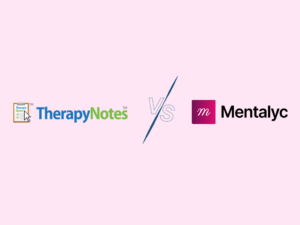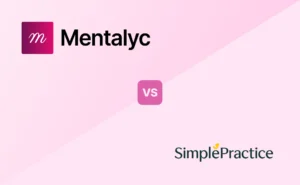Do you feel overwhelmed by how many progress notes you have to write as a mental health professional? Although essential for quality care, they can be tedious and time-consuming. But don’t worry, we’ve got you covered! We want to introduce you to the FIRP method – an incredibly effective and efficient way to take notes. With FIRP notes, you will have a simple and structured way to monitor your client’s progress, ensuring continuity of care and providing proof of your services. FIRP notes will make your life easier – no more struggling to remember every detail from your sessions. Not only will FIRP notes help you provide better care, but they will also simplify insurance reimbursement.
This guide will show you how to write high-quality FIRP notes that are comprehensive, clear, and easy to organize. You will get practical examples, tips, and a checklist to help you stay on track. By the end of this guide, you will be writing progress notes confidently and efficiently. Let’s make progress notes a cinch!
What Are FIRP Notes and Why Are They Essential for Mental Health Practitioners?
Keeping track of a patient’s progress is essential for their overall care. Progress notes are vital in helping healthcare professionals communicate and coordinate their efforts to ensure the patient stays on the right path. There are several types of clinical notes, including PIRP (problem, intervention, response, plan), GIRP (goal, intervention, response, plan), BIRP (behavior, intervention, response, plan), and FIRP (functioning, intervention, response, plan). Each format emphasizes a different aspect of patient progress, such as presenting problems, goals, response to therapy, and overall functioning.
The FIRP framework consists of four components that mental health practitioners can use to write progress notes that are comprehensive and effective. It is crucial to label each section of FIRP accordingly. Organized and practical, FIRP notes provide a way to track client progress, review sessions objectively, identify areas that need improvement, and adjust interventions accordingly. Using the FIRP format, you can gather valuable data to help guide treatment decisions and demonstrate outcomes to insurers with complete confidence.

New! Transfer your notes to EHR with a single click. No more copy-pasting.
Breaking Down the FIRP Method: Functioning, Intervention, Response, Plan
Functioning (Medical Necessity)
To provide the best possible service, it is essential to start each session by clearly understanding the client’s goals and objectives. The functioning section of the progress note should provide a concise description of the type of service the client will receive and how it relates to the client’s goals and objectives. Additionally, it should include any relevant clinical observations, the client’s current medical necessity to receive services, and any requests or direct statements made by the client.
To evaluate a client’s well-being, taking a constructive approach is essential. This can be achieved by assessing their current symptoms, behavior, mood, and significant life events that may impact them. Additionally, it’s important to inquire about their daily routine, recent changes, or ongoing challenges they may have encountered since the last session. By taking a constructive approach, you can help clients identify areas where they can make positive changes and work towards achieving their goals and objectives.
Some questions to consider:
- How are they coping with responsibilities at home or work?
- What is their mood and affect? Are there any concerns?
- How are they sleeping and eating? Any changes?
- What relationships or social interactions are they engaged in?
Things to note include:
- Client’s mood and affect: depressed, anxious, irritable, etc.
- Changes in sleep, appetite, energy level
- Difficulty concentrating or making decisions
- Substance use or abuse
- Relationship or family issues
Be specific and provide examples, such as:
- The client appeared optimistic, clearly discussing their goals for the week.
- The client was sad and tearful throughout the session, struggling with feelings of despair due to a recent loss.
Functioning section examples:
- The client presented as clean and appropriately dressed. Good eye contact and affect. Speech was clear and goal-directed.
- The client struggled with managing emotional reactivity during the session. They became tearful when discussing their relationship with their mother. Able to identify triggers and utilize coping skills with guidance.
Intervention
When composing the intervention section, it is essential to provide a comprehensive account of the actions taken, including any materials or handouts given to the client. Additionally, explain the themes discussed during the intervention and the extent of the client’s involvement and participation. Remember to highlight significant conversations or activities, such as practicing a challenging dialogue or establishing a gratitude routine.
Technique and Intervention examples include:
- Challenging negative or irrational thoughts
- Relaxation, deep breathing, and mindfulness techniques
- Explored insights gained from art therapy or journaling exercises.
- Assigned homework or worksheets.
- Employed cognitive reframing technique to help the client challenge and reframe their negative thoughts related to social anxiety.
- CBT techniques were used to schedule enjoyable events and boost social interaction with the client through cognitive restructuring and behavioral activation.
Intervention section examples:
- Provided client with validation and empathy regarding feelings about mother. Explored how the relationship has impacted self-esteem and interpersonal relationships. Discussed strategies for improving communication and setting boundaries.
- Taught client deep breathing techniques to help manage anxiety and distressing emotions. Role-played scenarios to practice assertive communication. Assigned homework to track emotions and triggers.
Response
One of the fundamental aspects of client care is observing and documenting their response to interventions. Within the response section, it’s crucial to note their receptiveness, motivation, or resistance level and monitor any changes in their mood, affect, and new insights. Evaluating the outcome of interventions and analyzing the client’s engagement and participation is also essential. Highlighting significant realizations or insights and determining whether the interventions positively impacted their mood, affect, or outlook is crucial for effective client care.
Examples of engagement, insights, mood changes, and breakthroughs:
- The client reported feeling less anxious after practicing deep breathing. Stated thoughts of judgment from others seemed less threatening.
- The client reported feeling calmer and more centered after mindfulness practice.
- Able to identify two negative thought patterns and reframe them into more constructive thoughts.
- Expressed feeling heard and understood, stating the role play helped address communication challenges with their partner.
- The client was receptive to developing a self-care plan and identified several coping strategies they will try this week. They appeared more optimistic and lighthearted by the end of the session.
- The client had an emotional breakthrough in discussing their relationship with their mother. Gained a new perspective but still fearful of confrontation.
Response section examples:
- The client was receptive to exploring the dynamics of their relationship with their mother. They expressed appreciation for empathy and support. Verbalized understanding of how past experiences have impacted present functioning and committed to trying strategies discussed to improve communication and set boundaries.
- The client engaged well in interventions. They were able to identify how anxiety manifests in thoughts and physical symptoms and committed to practicing deep breathing and mindfulness exercises as homework—plans to start tracking emotions and triggers to increase awareness and make changes.
Plan
As you wrap up your session with the client, discussing the next steps and planning for the future is essential. Consider recommendations, referrals, goals, and homework that will help your client continue to make progress. Explain your plan and guidance clearly, detailing any steps the client needs to take before the next session. By providing a clear plan for the future, you can help your client feel empowered and motivated to continue their journey towards wellness.
Discuss any obstacles and how the client will address them. For example:
- The client will start keeping a gratitude journal and spend 20 minutes each morning writing down things they are grateful for. We will review how this impacts their mood and motivation at our next meeting.
- Asked client to keep a thought journal this week to identify triggers of anxious thoughts and practice challenging them. We will continue CBT techniques focused on exposure hierarchies in the next session.
Provide any homework assignments, lifestyle changes, or additional resources. For example:
- Read chapters 1-3 in the anxiety workbook. Discuss insights/questions next week.
- Follow up with psychiatrist re: medication adjustment.
- Work on assertive communication for addressing issues with friends. Role play in the next session.
- Have a conversation with their partner implementing new communication strategies discussed today.
- Read the recommended book on coping with grief to support recent loss.
Plan section examples:
- Continue to discuss the relationship with their mother and how to improve dynamics. Encouragement and support—check-in on progress with assertiveness skills and boundary setting.
- Follow up on the use of coping strategies to manage anxiety and emotional reactivity. Continue mindfulness and deep breathing practice. Review homework and make adjustments as needed. Discuss additional strategies for anxiety management if required.
Examples and Templates for Creating FIRP Notes: Combining All the Necessary Components
Taking clear and concise notes during therapy sessions is crucial. One way to make progress notes more effective is to learn the elements of a practical FIRP note. Templates and examples can be a great help when writing your progress notes. While the FIRP method provides an easy-to-follow framework, looking at concrete examples can make it easier to understand. To get started, you can use the templates and examples provided in this article for your FIRP notes.
You should customize these templates to reflect your writing style and cater to each client’s requirements. With more practice, you can gain the ability to write FIRP progress notes that are both insightful and well-written. Adapting the templates to suit your client’s unique needs and therapy approach is crucial. As you practice more, this process will become more natural.
Complete FIRP Note Example #1:
F: The client reported feeling anxious and overwhelmed at work. Stated, “I can’t seem to catch up and I feel like I’m drowning.”
I: Explored the client’s anxiety and workload and asked clarifying questions about specific stressors and tasks. Discussed coping strategies to manage stress, like deep breathing, prioritizing important work, and leaving on time.
R: The client found the strategies helpful and felt less anxious after discussing the issues. They stated that they are feeling more in control and confident about managing responsibilities at work from now on.
P: Continue discussing coping strategies and stress management techniques. Review the client’s progress at the next session.
Complete FIRP Note Example #2:
F: The client disclosed experiencing symptoms of depression over the past month, including changes in sleep and appetite, low energy, and feelings of sadness. Stated, “I just feel blah and unmotivated lately.”
I: Assessed client for depression using the PHQ-9. Scored in the moderate range and discussed treatment options like therapy and medication. The client agreed to start an antidepressant and continue regular therapy sessions.
R: The client felt hopeful that by starting treatment, the symptoms of depression would improve over the next few weeks. Felt less distressed after discussing options and developing a plan.
P: Monitor the client for side effects and mood changes over the next month—Re-assess PHQ-9 scores at follow-up sessions to evaluate treatment progress and effectiveness. Adjust treatment plan as needed.
FIRP Note Template #1:
Client Name:
Date/Time:
Current Symptoms:
Interventions Discussed:
Client Response:
Next Steps/Changes to Plan:
FIRP Note Template #2:
Client Name:
Date/Time:
Mood:
Medication Effects/Side Effects:
Therapeutic Approach:
Client Progress/Response:
Next Session Goals:
FIRP Note Template #3:
Client Name:
Date/Time:
Therapy Techniques Used:
Client’s Reported Progress:
Client’s Experienced Challenges:
Changes in Symptom Severity:
Adjustments to Treatment Plan:
Writing Effective FIRP Progress Notes: Dos and Don’ts
To create progress notes that are both informative and insightful, implementing the FIRP model and adhering to the following tips is essential. By following best practices when writing FIRP progress notes, you can ensure that they are effective and well-received by your clients and colleagues. Keep the following dos and don’ts in mind to achieve success with your progress notes:
Do:
Organize Your Notes Chronologically.
Remember always to include the date and time at the top of your note to maintain a clear and organized timeline. This will help provide context for anyone reviewing the records. Organizing your notes chronologically is helpful when keeping track of your client’s progress, as it allows for an accurate timeline and history of their development. Doing so makes it easier to identify any patterns or changes that may have occurred.
Be Concise Yet Descriptive.
Aim for brevity while still noting key details. Be clear and objective, including the client’s symptoms, your interventions, their responses, and any changes to the treatment plan.
Evaluate Effectiveness and Make Changes as Needed.
Take note of what’s working well, what needs improvement, and any potential changes to the treatment plan. Being receptive to feedback and willing to try new approaches is also important. The most effective progress notes should document how interventions are helping the client make progress toward their treatment goals.
Get the Client’s Input When Possible.
Collaborate with your clients about their current challenges, symptoms, feelings, and needs. To assess their functioning and progress better, ask open-ended questions. It’s important to note their own words and observations in your entries, as clients often provide valuable insights into what is or isn’t working in their treatment.
Proofread and Double-Check for Errors Before Finalizing Notes.
Meticulously review every entry to ensure all information is accurately recorded before saving the notes to the client’s file or records. It is important to double-check for any typos, unclear statements, or missing details. Precise and high-quality progress notes are paramount for providing excellent care.
Focus on Facts.
Stick to objective observations of the client’s behavior, symptoms, mood, and functioning. Avoid personal opinions or judgments. Use specific examples and events to support your notes.
Don’t:
Use Jargon or Make Assumptions.
When writing notes, use plain language that anyone can understand. Avoid assuming the reader has background knowledge or making inferences.
Include Personal Opinions or Confidential Details.
Focus on observable facts and statements or behaviors of the client. Maintain boundaries and professionalism without disclosing private or stigmatizing information.
Include Identifying Details.
When writing, always protect the client’s privacy by not including identifiable details like their address or workplace. Use initials or “the client” instead of referencing them by name.
Write Haphazard or Disorganized Notes.
Take your time and be thoughtful. Disorganized or illegible notes are unprofessional and useless and may reflect poorly on you while failing to support your client’s treatment.
FIRP Notes FAQs: Your Top Questions Answered
You might have questions about FIRP notes and how they work. Don’t worry, we are here to help! Here are some of the most commonly asked questions and their answers:
What exactly are FIRP notes?
FIRP stands for Functioning, Intervention, Response, and Plan. FIRP notes are progress notes that follow a standardized format to document a client’s progress throughout treatment. They provide an easy way to record and track a client’s functioning, your therapeutic interventions, the client’s response, and future treatment plans.
How detailed do FIRP notes need to be?
When creating FIRP notes, it is necessary to be concise while including all relevant details about the session. Aim for three to five sentences for each FIRP element as a general rule of thumb. Use specific descriptions and explanations, providing exact examples from the session. However, avoid retelling the entire session verbatim. Only include details directly related to the client’s mental health and your treatment.
Do I have to use the FIRP format for all my progress notes?
Using the FIRP format to document a client’s progress and interventions is highly recommended. However, there may be instances where a brief update or a different style note may be more appropriate. Your clinical judgment should always guide you in determining the proper type of note for each session, ensuring that your notes accurately reflect the client’s mental health status and the treatment given. The crucial factor prioritizes accuracy in representing the client’s progress and treatment.
What are the benefits of using FIRP notes?
Keeping track of a client’s progress is integral in providing effective care. FIRP notes make this process simple and efficient by ensuring that important details are recorded in a standardized format, which reduces errors, omissions, and inconsistencies. By utilizing FIRP notes, you can streamline the note-writing process, improve continuity of care, and ultimately provide better outcomes for your clients.
How long should I spend writing FIRP notes?
Most FIRP notes can be compiled efficiently within 10 to 15 minutes for most sessions. As you gain experience, the process becomes quicker. Below are some tips for writing FIRP notes effectively:
- Focus on capturing essential details in concise yet comprehensive notes.
- Use dictation or shorthand to quickly draft notes, which can be reviewed and edited later for clarity and completeness.
- Have a template ready for each client, which can be updated with specifics from the session, saving time and avoiding starting from scratch.
- Review your previous FIRP note before writing a new one to refresh your memory and build on what you documented previously.
- During sessions, keep a scratch pad or use Mentalyc’s built-in recorder to quickly write or record crucial details to include in your notes.
How often should I write FIRP notes?
We recommend writing FIRP notes right after every therapy session to capture the essential details while they are still fresh in your mind. Some therapists prefer to review and update these notes between sessions as required. However, the frequency of this practice may vary depending on your practice, client needs, and personal preference.
Do you have any tips for getting started with FIRP notes?
When writing FIRP notes, starting with the Functioning and Intervention sections is best. As you gain more experience, you can incorporate the Response and Plan sections. Reviewing some examples helps determine what details should be included in each area. Creating FIRP note templates can also make the process more streamlined and efficient.
Conclusion:
You have the power to take your practice to the next level! With FIRP notes, you can revolutionize the care you provide your clients. By understanding the importance of these notes, you’ll gain valuable insight into your clients’ progress and outcomes, which will help you give even higher-quality care. You don’t have to be a master writer to create effective notes; you only need to keep them concise, organized, and specific. Consistency is key, and with the guidelines and examples provided, you can create personalized notes that genuinely capture the essence of each session.
So, let your newfound knowledge of FIRP notes empower you to continue the vital work you do every day, supporting and caring for those who need it most. And with Mentalyc, you can effortlessly manage your progress notes. Say goodbye to tedious typing and note-taking – speak naturally and let Mentalyc handle the rest. Give it a try today and experience hassle-free progress notes that will actually make your life easier.
Resources:
- Mental Health Outpatient Documentation Manual. Humboldt County Health and Human Services. (2014, August). https://humboldtgov.org/DocumentCenter/View/6560/IHBS-RFP-Exhibit-D—Outpatient-Documentation-Manual
Disclaimer
All examples of mental health documentation are fictional and for informational purposes only.
Why other mental health professionals love Mentalyc

“Having Mentalyc take away some of the work from me has allowed me to be more present when I’m in session with clients … it took a lot of pressure off.”
LPC

“It’s so quick and easy to do notes now … I used to stay late two hours to finish my notes. Now it’s a breeze.”
Licensed Professional Counselor

“By the end of the day, usually by the end of the session, I have my documentation done. I have a thorough, comprehensive note … It’s just saving me hours every week.”
CDCII

“A lot of my clients love the functionality where I can send them a summary of what we addressed during the session, and they find it very helpful and enlightening.”
Therapist






